Westgate-on-Sea
Westgate-on-Sea is a seaside town and civil parish in northeast Kent, England, with a population of 6,996 at the 2011 Census.[1] It is within the Thanet local government district and borders the larger seaside resort of Margate. Its two sandy beaches have remained a popular tourist attraction since the town's development in the 1860s from a small farming community.
| Westgate-on-Sea | |
|---|---|
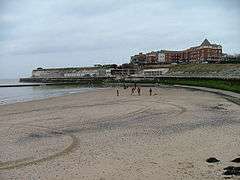 West Bay | |
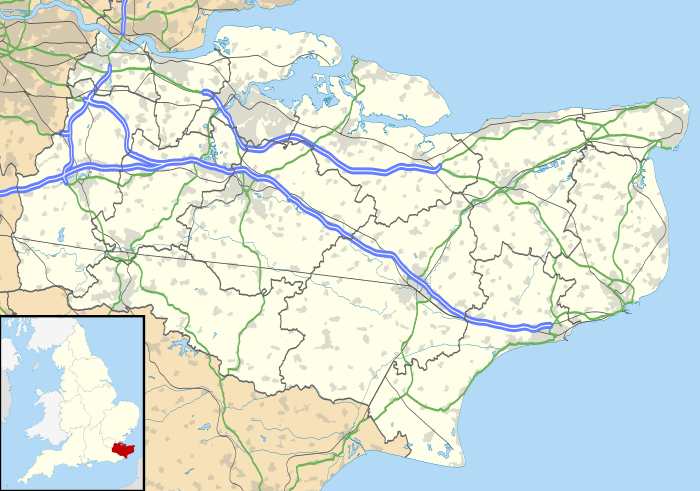 Westgate-on-Sea Location within Kent | |
| Population | 6,996 (2011) |
| OS grid reference | TR321701 |
| Civil parish |
|
| District | |
| Shire county | |
| Region | |
| Country | England |
| Sovereign state | United Kingdom |
| Post town | WESTGATE-ON-SEA |
| Postcode district | CT8 |
| Dialling code | 01843 |
| Police | Kent |
| Fire | Kent |
| Ambulance | South East Coast |
| UK Parliament | |
The town is notable for once being the location of a Royal Naval Air Service seaplane base at St Mildred's Bay, which defended the Thames Estuary coastal towns during World War I. The town is the subject of Sir John Betjeman's poem, "Westgate-on-Sea". Residents have included the 19th-century surgeon Sir Erasmus Wilson and former Archbishop of Canterbury William Temple. The artist Sir William Quiller Orchardson painted several of his best-known pictures whilst living in Westgate-on-Sea. The British composer Arnold Cooke attended the town's Streete Preparatory School in the early 20th century, and Eton headmaster Anthony Chenevix-Trench spent the earliest few years of his education in the town.[2]
History
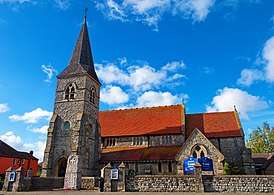
Before the 1860s, Westgate consisted of only a farm, a coastguard station (built 1791 and still standing in Old Boundary Road) and a few cottages for the crew that surrounded it. These were located beside the coast at St Mildred's Bay, named after Mildrith, Thanet's patron saint and a one-time Abbess of Minster. The town inherited its name from the Westgate Manor, which was located in the area in medieval times. In the early 20th century, the remains of a Roman villa were discovered in what is now Beach Road, where a stream once used to flow. Fresh water can still be seen rising from the sand at low tide.
During the late 1860s, businessmen developed the area into a seaside resort for the upper to middle-classes.[3] A stretch of sea wall, with promenade on top, was constructed around the beaches at St Mildred's Bay and West Bay, and the land divided into plots to be sold for what would become an exclusive development by the sea for wealthy metropolitan families[4] within a gated community, rather than for occasional tourists.[5][6] The opening of a railway station, in 1871, led to the rapid expansion of the population,[3] which reached 2,738 by 1901.[7] The demands of the increasing population led to the building of the parish churches of St. James in 1872[8] and St. Saviour in 1884.[9] St. Saviour's was designed by the architect C.N. Beazley.[9] In 1884 it was reported that Essex, on the other side of the Thames Estuary, was hit by a tremor so large that it caused the bells of St. James' Church to ring.[10] In 1884, ownership of most of the resort passed to Coutts Bank, after the previous proprietors had gone bankrupt.[5][11]
Around twenty schools were opened during the late 19th century, although many had only a few pupils or closed within a few years. The largest of the schools were Streete Court School, Wellington House Preparatory School and St Michael's School.[12][13][14]
An early experiment with electric lighting took place in December 1878. Six Yablochkoff lamps – a type of arc light – were installed, they were powered by a Garrett engine and were lit for 96 hours. The running costs proved to be uneconomic: they cost £40 9s 5d compared to £16 15s 2d for gas lighting, and there were technical problems.[15]
Wellington House was established in 1886 by two clergymen, the Bull brothers. It closed in 1970 and was demolished in 1972. Old boys included Doctor Who actor Jon Pertwee and cabinet minister John Profumo, known for his involvement in the Profumo affair.[16][17] Streete Court School was opened in 1894 by John Vine Milne, the father of the author A. A. Milne. In the 1890s, the school was attended by St John Philby, the father of the spy Kim Philby.[18][19]
The Coronation Bandstand was built by the cliff edge in 1903, at a cost of £350, to celebrate the coronation of King Edward VII.[20] The following year, a group of French Ursuline nuns, who were banned from teaching in France, fled with some of their pupils to Westgate-on-Sea and established the Ursuline Convent School, which in 1995 was re-established as Ursuline College.[21] In 1910, a Swiss-Gothic styled town hall was built. However, it was soon decided that the building could be put to better use, and in 1912, it was transformed into the Town Hall Cinema. In 1932, it was renamed the Carlton Cinema.[22]
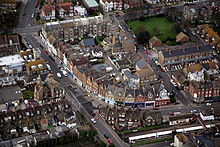
On 1 August 1914, after the outbreak of World War I, a Royal Navy seaplane base was opened by the coast to defend the Thames Estuary naval towns against attack. It was at first used for both seaplanes and landplanes, but due to landing problems, a separate landplane base was opened in Manston in 1916. After the war, the seaplane base was decommissioned, and the landplane base in Manston eventually became Kent International Airport.[23][24] During the war, the Coronation Bandstand was converted into sleeping quarters for use by the Royal West Kent Regiment. In 1925, the bandstand was refurbished and reopened as the 600-seat Westgate Pavilion theatre.[25] By 1931, the town's population had reached 4,554.[7] During World War II, several schools were evacuated to inland areas,[21][26] with some, such as Streete Court School, leaving the town permanently.[19] On 24 August 1942, a German fighter pilot, Herbert Bischoff, was captured after being shot down and crash landing in a field adjacent to Linksfield Rd, just south of the town.[27][28]
On 27 April 1944 a Liberator aircraft from the 392nd USAAF bombing group based in East Anglia near Wendling, Norfolk, crashed off the beach, adjacent to the Westgate Pavilion, with five of the crew killed and four injured in the crash. A special memorial service was held for the crew by the Mayor of Margate and veterans' organisations on 27 April 2009 at the war memorial overlooking the crash site.
In 1975, five historic church bells were transferred to St Saviour's Church from the Holy Cross Church in Canterbury, which had closed in 1972. Three of the bells date back to the early 17th century and one was cast in the 14th century.[29] From the 1970s to the 1990s, the Westgate Pavilion was a bingo hall, after which it closed and became derelict. In 2001, a group of volunteers formed a charitable trust to repair the pavilion and it was eventually reopened as a theatre.[25]
Geography
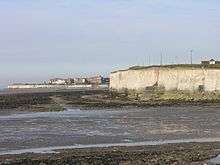
Westgate-on-Sea is located in northeast Kent, on the coast of the Thames Estuary. It is bordered by the town of Margate to the east and the village of Birchington-on-Sea to the west. The town is built beside the two sandy bays of St Mildred's Bay and West Bay, which both have a sea wall and groynes to prevent coastal flooding. Chalk cliffs are present in between the bays and either side of the bays. The whole of the northeast Kent coast has been designated a Site of Special Scientific Interest.[30]
The town lies on the Isle of Thanet, a separate island from mainland Kent until around two hundred years ago, when the channel in between silted up. The geology of Thanet consists mainly of chalk, deposited when the area was below the sea. The Isle of Thanet was formed when the English Channel was formed by the sea breaking through, an island of chalk being left on the east side of the county. It was separated from the rest of Kent by the Wantsum Channel.[31]
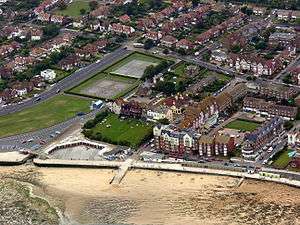
Climate
In East Kent, the warmest time of the year is July and August, when maximum temperatures average around 21 °C (70 °F). The coolest time of the year is January and February, when minimum temperatures average around 1 °C (34 °F).[32] The average of maximum and minimum temperatures are around 1/2 °C higher than the national average.[33] East Kent's average annual rainfall is about 728 millimetres (29 in), with October to January being the wettest months,[32] compared with the national average of 838 millimetres (33 in).[33]
These are average temperature and rainfall figures taken between 1971 and 2000 at the Met Office weather station in Wye, around 25 miles (40 km) southwest of Westgate-on-Sea:
| Climate data for Wye Weather Station, Wye, Kent, England | |||||||||||||
|---|---|---|---|---|---|---|---|---|---|---|---|---|---|
| Month | Jan | Feb | Mar | Apr | May | Jun | Jul | Aug | Sep | Oct | Nov | Dec | Year |
| Average high °C (°F) | 7.1 (44.8) |
7.2 (45.0) |
9.9 (49.8) |
12.1 (53.8) |
15.9 (60.6) |
18.7 (65.7) |
21.3 (70.3) |
21.6 (70.9) |
18.4 (65.1) |
14.5 (58.1) |
10.3 (50.5) |
8.0 (46.4) |
13.8 (56.8) |
| Average low °C (°F) | 1.5 (34.7) |
1.3 (34.3) |
2.8 (37.0) |
4.3 (39.7) |
7.3 (45.1) |
9.9 (49.8) |
12.2 (54.0) |
12.2 (54.0) |
10.1 (50.2) |
7.2 (45.0) |
3.9 (39.0) |
2.6 (36.7) |
6.3 (43.3) |
| Average precipitation mm (inches) | 72.0 (2.83) |
44.7 (1.76) |
53.5 (2.11) |
50.8 (2.00) |
45.3 (1.78) |
51.8 (2.04) |
47.1 (1.85) |
55.9 (2.20) |
65.3 (2.57) |
85.4 (3.36) |
78.7 (3.10) |
77.3 (3.04) |
727.9 (28.66) |
| Source: Met Office[34] | |||||||||||||
Transport links
Westgate-on-Sea railway station is on the Chatham Main Line, which runs between Ramsgate in East Kent and London Victoria. Other stations on this line include Broadstairs, Margate, Herne Bay, Faversham, Gillingham, Rochester and Bromley South.[35] Westgate-on-Sea is around 1 hour and 45 minutes to London by fast-service train. A National Express coach service runs between London Victoria and Ramsgate,[36] and a selection of trains run to London's Cannon Street station, primarily for business commuting. There is a Stagecoach bus service running to neighbouring Birchington and Margate, and a service running between Broadstairs and Canterbury via Westgate-on-Sea.[37] The A28 road runs between Hastings and Margate via Ashford, Canterbury, Birchington and Westgate-on-Sea. 4 miles (6 km) southwest of Westgate-on-Sea, the A28 crosses the A299 road, which leads along North Kent towards London, becoming the M2 motorway at Faversham.[38]
Demographics
| Westgate-on-Sea Compared | |||
|---|---|---|---|
| 2001 UK census | Westgate-on-Sea | Thanet District | England |
| Total population | 6,594 | 126,702 | 49,138,831 |
| Foreign born | 6% | 5% | 9% |
| White | 97% | 98% | 91% |
| Asian | 1% | 1% | 5% |
| Black | 0% | 0% | 2% |
| Christian | 76% | 74% | 72% |
| Muslim | 1% | 1% | 3% |
| Hindu | 0% | 0% | 1% |
| No religion | 14% | 16% | 15% |
| Over 65 years old | 27% | 22% | 16% |
| Unemployed | 4% | 4% | 3% |
At the 2001 UK census, the Westgate-on-Sea electoral ward had 6,594 residents and 2,845 households. Of those households, 38.0% were married couples, 8.4% were cohabiting couples and 9.4% were lone parents. 39.2% of all households were made up of individuals and 21.9% had someone living alone at pensionable age. 23.6% of households included children aged under 16, or a person aged 16 to 18 who was in full-time education. There was a high percentage of households made up of individuals, compared with the percentage for the whole of England. The average household size was 2.7.[39]
The town has a low proportion of non-white people compared to national figures; the ethnicity recorded in the 2001 census was 97.4% white, 1.0% mixed race, 0.4% Chinese, 0.6% other Asian, 0.3% black and 0.3% other.[39] The number of foreign-born residents is relatively low, with the place of birth of residents in 2001 being 94.5% United Kingdom, 1.0% Republic of Ireland, 0.5% Germany, 0.6% other Western Europe countries, 0.3% Eastern Europe, 0.8% Far East, 0.6% North America, 0.5% Africa, 0.4% South Asia, 0.2% Middle East and 0.2% Oceania.[39] Religion was recorded as 75.8% Christian, 0.5% Muslim, 0.2% Hindu, 0.1% Buddhist and 0.3% Jewish. 14.4% were recorded as having no religion, 0.3% had an alternative religion and 8.3% did not state their religion.[39]
The age distribution was 5% aged 0–4 years, 13% aged 5–15 years, 5% aged 16–19 years, 28% aged 20–44 years, 22% aged 45–64 years and 27% aged 65 years and over. There was a high percentage of residents over 65, compared with the national average of 16%, mainly due to seaside towns being popular retirement destinations. For every 100 females, there were 85.7 males.[39]
Economy
As a seaside resort, the economy is mainly based around tourism; there are several hotels and guest houses near the seafront, to accommodate the influx of visitors during the summer. The High Street has a variety of shops and services, and there are a small number of factories. The elderly population has led to many health and social care jobs at local care homes. At the 2001 UK census, 6.9% of the population resided in a medical or care establishment, compared with the national average of only 0.8%.[39]
At the 2001 census, the economic activity of residents in the Westgate-on-Sea electoral ward was 32.9% in full-time employment, 12.3% in part-time employment, 7.8% self-employed, 4.3% unemployed, 2.1% students with jobs, 4.3% students without jobs, 18.1% retired, 6.2% looking after home or family, 9.5% permanently sick or disabled and 2.3% economically inactive for other reasons. The percentage of retired people was significantly higher than the national figure of 14% and the percentage of unemployed people was high compared with the national rate of 3.4%. The number of permanently sick or disabled people was much higher than the national figure of 5.3%. 12% of residents aged 16–74 had a higher education qualification or the equivalent, compared with 20% nationwide.[39] The Office for National Statistics estimated that during the period of April 2001 to March 2002, the average gross weekly income of households was £430 (£22,421 per year).[40]
The industry of employment of residents, at the 2001 census, was 16% retail, 16% health and social work, 13% manufacturing, 9% construction, 9% real estate, 9% education, 7% transport and communications, 5% public administration, 5% hotels and restaurants, 3% finance, 1% agriculture and 6% other community, social or personal services. Compared with national figures, there was a relatively high number of workers in the construction and health and social care industries and a relatively low number in finance and real estate.[39] Many residents commute to work outside the town; at the 2001 census, the town had 2,388 employed residents, but only 1,464 jobs.[39]
Politics
Since the constituency was created in 1983, the Member of Parliament for North Thanet, covering northern Thanet and Herne Bay, has been the Conservative Roger Gale. At the 2005 general election, the Conservatives won a majority of 7,634 and 49.6% of the vote in North Thanet. Labour won 32.2% of the vote, Liberal Democrats 14.4% and UK Independence Party 3.9%. At the 2001 general election, the Conservatives had a higher share of the vote with 50.3% but a lower majority of 6,650. During Labour's landslide victory at national level at the 1997 general election, the Conservative majority in North Thanet was reduced to 2,766, with the Conservatives on 44.1% of the vote and Labour on 38.4%. The voter turnout during the past three general elections has been between 59.3% and 68.8%.[41]
The town is in the Thanet local government district. It is within the electoral ward of Westgate-on-Sea, which has three of the fifty-six seats on the Thanet District Council. At the 2007 local elections, two of those seats were won by the Conservative Party and one by an independent candidate.[42] Conservative candidates in the ward won 45.8% of the vote, independent candidates won 27.0%, Labour Party candidates 17.6% and a Grey Party candidate 4.6%. The turnout was 34.5%.[43]
In 2015 Thanet Council set up a parish council for the Westgate-on-Sea ward. The new council took office at its first meeting in May 2015 as Westgate-on-Sea Town Council. It meets in Westgate-on-Sea Town Hall.[44]
Education
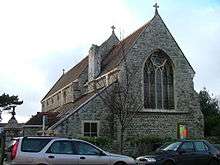
The town's secondary school is Ursuline College, a specialist Sports College and Roman Catholic aided comprehensive school, with nearly 800 pupils and facilities for boarding students.[45] In 2005, 32% of its pupils gained at least five GCSEs at grades A*–C including English and maths, ranking it 71st out of Kent's 120 secondary schools.[46] Many secondary students commute to schools in other nearby towns, especially to the grammar schools in Ramsgate and Broadstairs. The Westgate College For Deaf People for students aged 16 and over[47] closed on 11 December 2015. An inspection the previous month by the Care Quality Commission uncovered what the inspectors called "shocking examples of institutionalised failings and abuse" and the trust running the schools subsequently went into administration.[48] The London House School of English provides English language courses for foreign students.[49]
The primary state schools are St Crispin's Infant School and St Saviour's Church of England Primary School,[50] which is owned by the church but run by Kent County Council.[51] Chartfield School is an independent primary school, educating children from 3 to 11 years.[52]
Recreation
The town has sandy beaches at both St Mildred's Bay and West Bay. The larger of the beaches is at St Mildred's Bay, where it is possible to hire beach huts, deck chairs and jet-skis. The beach is a short distance from tennis courts and a golf putting course. At West Bay, there are many small rock pools, which are popular with children. Each beach has nearby cafés, restaurants and public houses, and a European Blue Flag Award is shared between them due to their cleanliness and safety.[53]
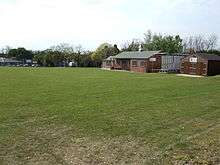
The town centre has several Victorian canopied shops, a library and the three-screen Carlton Cinema. In addition to the theatre, the Westgate Pavilion is a venue for discos, yoga, indoor bowls and dance classes.[25]
Formed in 1896,[54] Westgate and Birchington Golf Club has an 18-hole 4,889-yard (4,471 m) course on the cliff tops between Westgate and Birchington.[55] Based at Hawtreys Field, Westgate-on-Sea Cricket Club runs two Saturday teams and two Sunday teams. In the 2007 season, both Saturday teams played in the Kent Cricket Feeder League East; the Saturday 1st XI team in Division 1C and the Saturday 2nd XI in Division 2C. The Sunday teams do not play in competitive matches.[56] In 2006, Thanet Council opened a free skatepark at the Lymington Road recreation ground. Designed by local young people, the park caters for skateboarders and in line skaters of all ages and skill levels.[57]
Local media
Newspapers
There are four local weekly newspapers providing news on the Thanet district area. Isle Of Thanet KM Extra is owned by the KM Group,[58] and the Isle of Thanet Gazette, Thanet Adscene and Thanet Times are owned by Trinity Mirror.[59] Isle Of Thanet KM Extra and Thanet Adscene are free newspapers, whereas the other two are paid-for. Kent on Sunday published newspapers covering this area until 2017.
Radio
KMFM Thanet is a radio station on frequency 107.2FM, owned by the KM Group and previously known as TLR (Thanet Local Radio).[60] Community radio station Academy FM (Thanet) launched in 2010 on 107.8.[61]
Notable residents
Residents of the town have included:
- the 19th-century surgeon Sir Erasmus Wilson, who spent the latter part of his life in the town until his death in 1884.[62]
- former Archbishop of Canterbury William Temple, who died in the town in 1944.[63]
- In 1888, the astronomer and journalist Joseph Norman Lockyer built an observatory on the side of his house in Westgate-on-Sea, from where he took observations that formed the basis for his book, The Sun's Place in Nature.[64]
- British composer Arnold Cooke attended Streete Preparatory School in the early 20th century.[65]
- Ann Dowling, the first woman to be President of the Royal Academy of Engineering, attended Ursuline Convent School in the town.[66]
- The artist Sir William Quiller Orchardson painted several of his most well-known pictures while living in Westgate-on-Sea. He was buried in the town in 1910.[67]
- In 1957, suspected serial killer Dr John Bodkin Adams spent two weeks in hiding in the town (to escape the press) following his controversial acquittal at the Old Bailey.[68]
- Louis Wain (1897–1939), the man who drew cats and illustrated many children's book, lived in Westgate at Adrian Square, then in 1895 he moved to Collinwood Terrace, now known as Westgate Bay Avenue.
- Actress Juliette Kaplan, known for her role as Pearl in the long running sitcom Last of the Summer Wine, lived here.[69]
References
- "Margate Ward population 2011". Retrieved 3 October 2015.
- Peel, Mark (1996). The land of lost content: the biography of Anthony Chenevix-Trench. Edinburgh: Pentland Press. ISBN 1-85821-400-9.CS1 maint: ref=harv (link)
- Mirams, Michael (1984). Old Margate. Maresborough Books.
- Crouch, Dr Dawn (2008). Historic Westgate on Sea : The Built Environment. Westgate on Sea Heritage Centre.
- The British Seaside: Holidays and Resorts in the Twentieth Century (Studies in Popular Culture). Manchester University Press. 2000. ISBN 0-7190-5169-X.
- "The Boltons and Redcliffe Square area - The Gunter estate, 1864–78". British History Online. Archived from the original on 9 June 2007. Retrieved 28 May 2001.
- "A vision of Westgate on Sea CP". VisionOfBritain.org.uk. Retrieved 28 May 2007.
- "An Abbreviated History". St. James' Church. Archived from the original on 16 July 2007. Retrieved 22 April 2007.
- Limited, Beachshore Design. "St Saviour's Parish Church : Westgate on Sea Heritage Centre : Museum on Isle of Thanet Kent". www.westgateheritagecentre.org.uk.
- "Weather: this week in history". BBC. Archived from the original on 5 September 2005. Retrieved 29 March 2007.
- "The Boltons and Redcliffe Square area: The area after 1878". British-History.ac.uk. Archived from the original on 9 June 2007. Retrieved 29 May 2007.
- Census Returns of England and Wales, 1881 Public Record Office RG11 Pieces 983–985.
- Census Returns of England and Wales, 1891 Public Record Office RG12 Pieces 725–726.
- Census Returns of England and Wales, 1901 Public Record Office RG13 Piece 820.
- The Electricity Council (1987). Electricity Supply in the United Kingdom: a Chronology. London: The Electricity Council. p. 11. ISBN 085188105X.
- "Wellington House School WW1 and WW2". War Memorials Archive. Imperial War Museum. Retrieved 19 September 2014.
- Evans, Nick (11 August 2008). "Canings and compulsory daily runs – welcome to my school days!". Kent Online. Rochester, Kent: KM Group. Retrieved 19 September 2014.
- Eminent Georgians: The Lives of King George V, Elizabeth Bowen, St. John Philby, and Lady Astor. Palgrave Macmillan. 1997. p. 132. ISBN 0-312-17685-6.
- "Streete Court School". streetecourtschool.co.uk/. Archived from the original on 19 June 2003. Retrieved 23 May 2007.
- "The Westgate Pavilion". WestgatePavilion.org.uk. Retrieved 29 March 2007.
- "History of Ursuline College Westgate". Comenius-St-Angela.org. Archived from the original on 8 October 2007. Retrieved 29 March 2007.
- "Carlton Cinema". CinemaTreasures.org. Retrieved 27 May 2007.
- "Kent International Airport". AirportGuides.co.uk. Retrieved 29 May 2007.
- Military Airfields of Britain: South East Kent,Hampshire,Surrey,Sussex. The Crowood Press. 2005. p. 266. ISBN 1-86126-729-0.
- "The Westgate Pavilion". WestgatePavilion.org.uk. Archived from the original on 18 November 2015. Retrieved 17 November 2015.
- "Manors and other estates". British-History.ac.uk. 1992. Archived from the original on 27 September 2007. Retrieved 29 May 2007.
- Jagdgeschwader 52: The Experten. Osprey Publishing. 2004. p. 31. ISBN 1-84176-786-7.
- The Luftwaffe Fighters' Battle of Britain. Crecy Publishing Ltd. 2001. p. 200. ISBN 0-947554-81-5.
- "Westgate-on-Sea, St Saviour". Church Bells of Kent. Archived from the original on 10 November 2006. Retrieved 29 March 2007.
- "Geological Sites Map". Natureonthemap.org.uk. Retrieved 24 April 2007.
- "Isle of Thanet". BBC. Retrieved 29 March 2007.
- "Wye 1971–2000 averages". Met Office. Archived from the original on 29 September 2007. Retrieved 29 March 2007.
- "England 1971–2000 averages". Met Office. Retrieved 29 March 2007.
- "Wye 1971–2000 averages". UK government. Archived from the original on 29 September 2007. Retrieved 9 January 2008.
- "Timetable". National Rail Enquiries. Archived from the original on 28 March 2007. Retrieved 29 March 2007.
- "Timetable". National Express. Retrieved 29 March 2007.
- "Stagecoach Bus". Stagecoach. Retrieved 29 March 2007.
- "Map". Yahoo.com. Retrieved 29 March 2007.
- "Neighbourhood Statistics". Statistics.gov.uk. Archived from the original on 25 May 2011. Retrieved 29 March 2007.
- "Model-Based Estimates of Income for Wards". Statistics.gov.uk. Retrieved 29 March 2007.
- "Thanet North". London: Guardian.co.uk. Retrieved 29 March 2007.
- "Councillors". Thanet District Council. Archived from the original on 18 May 2007. Retrieved 29 March 2007.
- "District Council Election" (PDF). Thanet District Council. 2007. Archived from the original (PDF) on 16 June 2007. Retrieved 26 May 2007.
- "About Us". Westgate-on-Sea Town Council. Archived from the original on 11 March 2016. Retrieved 11 March 2016.
- "Ursuline College". Ursuline College. Retrieved 29 March 2007.
- "Schools in Kent". BBC. 19 October 2005. Retrieved 24 April 2007.
- "The Royal School for Deaf Children Margate". rsdcm.org.uk. Archived from the original on 7 September 2011. Retrieved 29 March 2007.
- "Margate deaf students 'abused and harmed'". BBC News Online. 5 April 2016. Retrieved 5 April 2016.
- "Directory of English language courses". Europa-pages.com. Retrieved 29 March 2007.
- "UK Schools and Colleges Database". Schoolswebdirectory.co.uk. Retrieved 29 March 2007.
- "Schools and the Church of England". Church of England. Archived from the original on 3 February 2007. Retrieved 29 March 2007.
- "Chartfield School". IndependentSchools.com. Retrieved 29 March 2007.
- "West Bay, Westgate". BlueFlag.org.uk. Archived from the original (PDF) on 27 September 2007. Retrieved 29 March 2007.
- "Westgate and Birchington Golf Club". Westgate and Birchington Golf Club. Retrieved 6 June 2007.
- "Westgate and Birchington Golf Club". intotherough.co.uk. Archived from the original on 13 April 2014. Retrieved 29 June 2012.
- "Westgate-on-Sea Cricket Club". Westgate-on-Sea Cricket Club. Archived from the original on 20 July 2012. Retrieved 6 June 2007.
- "Take off for Westgate Skate Park". Thanet District Council. Archived from the original on 31 October 2007. Retrieved 23 April 2007.
- "KM Publications". Kent Online. Retrieved 14 April 2007.
- "Regionals". Trinity Mirror. Archived from the original on 27 January 2007. Retrieved 14 April 2007.
- "KMFM". media.info. Retrieved 26 June 2015.
- "Academy FM". media.info. Retrieved 26 June 2015.
- "Wilson, Sir William James Erasmus". Plarr's Lives of the Fellows Online. Retrieved 23 April 2007.
- "William Temple". SchoolNet.co.uk. Archived from the original on 23 April 2007. Retrieved 23 April 2007.
- Agnes Mary Clerke and the Rise of Astrophysics. 2002. pp. 53–55. ISBN 0-521-80844-8.
- "Arnold Cooke Biography". Musicweb-international.com. Retrieved 23 April 2007.
- Ashton, James (2 November 2014). "Ann Dowling – interview: 'Engineering should be central to society'". The Independent. Retrieved 29 July 2016.
- Dictionary of National Biography: Second Supplement. Volume 3. Adamant Media Corporation. 2001. pp. 50–51. ISBN 0-543-88108-3.
- Cullen, Pamela V., A Stranger in Blood: The Case Files on Dr John Bodkin Adams, London, Elliott & Thompson, 2006, ISBN 1-904027-19-9
- "Kent Life interviews Juliette Kaplan". Kent Life. Archant Community Media. 27 March 2012. Archived from the original on 19 October 2019. Retrieved 16 August 2020.
External links
| Wikimedia Commons has media related to Westgate-on-Sea. |

